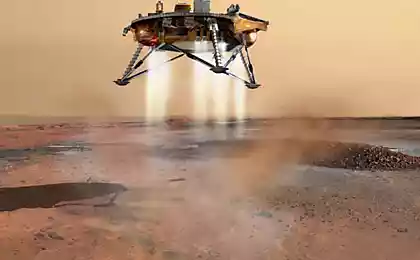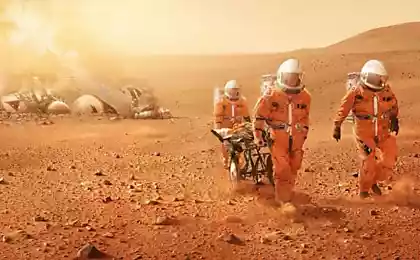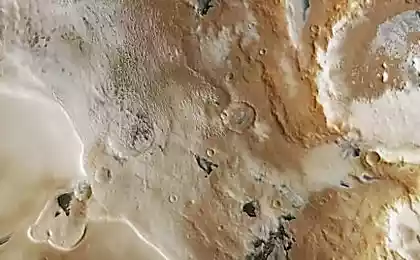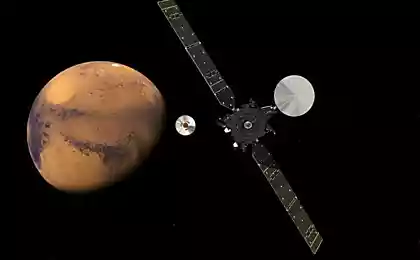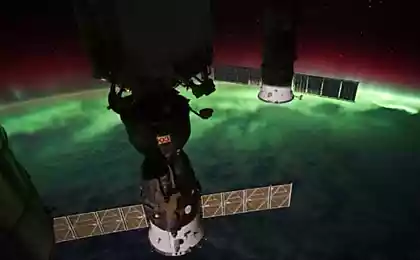845
New NASA Mars 2020 rover will search for traces of life on the Red Planet
At NASA recently told about the details of the new mission
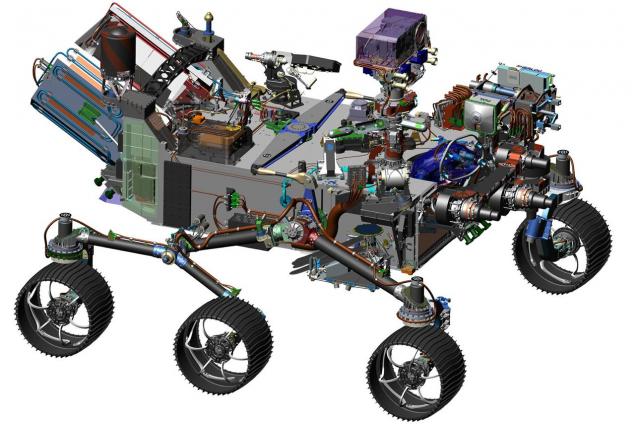
To the question "Is there life on Mars?" Scientists still have no answer. Specifically, it could be sooner. There may be in one form or another and now. But all this - the assumptions and assumptions without a clear answer. To get the answer, NASA proposes to send a new rover to Mars, called the Mars 2020.
The agency issued a "roadmap" of the rover landing on Mars. Until the date of the final stage of the journey - in February 2021. Posted image and future rovers. All stages of preliminary preparation for the implementation of the project completed.
The new phase involves the approval of the final version of the structure of the rover and the beginning of the manufacture of individual elements of the system. Once all the parts are made, the system will begin assembly, check its functionality and sending a rover to the launch site. The transition to this phase, according to project manager George Tau (George Tau) should occur in the next year.
Since 2020 Mars mission is the "heir" Curiosity mission, structure and some elements of the new rover is very similar to what was used in the Curiosity. This scientist did not have to re "reinvent the wheel" by creating a Mars 2020. Some key parts and components have made the rover as technical base remained from the previous project.
Model 2020 will collect Martian soil samples and check them for signs of microbial life. This problem is not posed in front of Curiosity. 2020 rover will have to collect and store the selected samples - of the predecessor also did. Samples were once planned to send to Earth for further inspection. So far, specific plans for this stage there is no mission. "Mission Mars 2020 - the first step in a multi-stage campaign for the return of the sealed and collected images of the Martian rocks. The mission is an important milestone in the implementation of the program Journey to Mars. The purpose of the program - to determine whether there was life on Mars before ... "- said Dzhoffri Yoder (Geoffrey Yoder), one of Mars 2020. program managers select and put into sealed capsule is scheduled for 30 of the most interesting science rocks of Mars samples.
It is known that the rover will explore Mars in 2020 is one of the regions of the Red Planet, which, as scientists believe, was previously the existence of a favorable environment for microbial life. While the region is not defined - scientists are considering several possible places of interest in terms of research.

At Mars rover in 2020 will be 7 major scientific instruments. General equipment rover - better than Curiosity. The first tool - this is the main chamber of the rover (the part that looks like a robot's head). The camera is more perfect than the camera, which was equipped with Curiosity. Mastcam-Z can make panoramic images and stereoscopic images as the camera 2020 predecessor model. But she has more optical zoom than the previous model. In fact, all of the cameras in 2020 Mars better than at Curiosity, the rover Plus except video and can record sound. And of course, the new rover will also be able to do selfie.
SuperCam the model 2020 - this is an advanced version of ChemCam, Curiosity instrument. In fact, this powerful laser gun, which the rover will "shoot" on the rocks of Mars and analyze the products formed. All of this allows us to identify and understand the elementary mineral composition of the rock. After receiving the data on the analysis of rocks, Earth scientists decide to prioritize the study of various regions of Mars, where lie the different rocks.
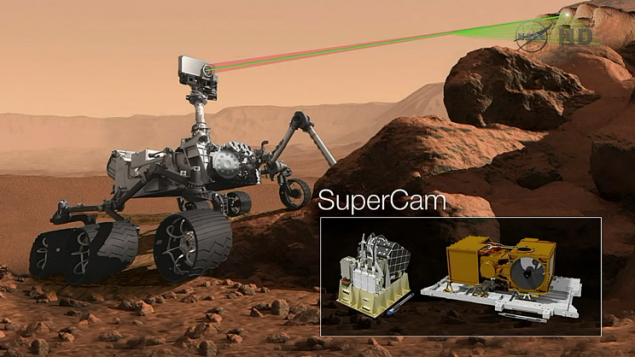
The third tool rover - MOXIE (Mars Oxygen ISRU Experiment). It will capture carbon dioxide and converting it into pure oxygen. This experiment will help you understand to be seen whether future colonists on Mars getting enough for the needs of the colony oxygen. Oxygen is needed for the creation of rocket fuel.
The fourth tool - MEDA Mars (Environmental Dynamics Analyzer). It is necessary to study the Martian weather. Sensors measure the device temperature, wind speed and direction, pressure, relative humidity, the size and shape of dust
The fifth tool - RIFMAX. It georadiolokator. He will be able to "look" at the surface of Mars to a depth of 10 meters (some sources say 500 m) with a resolution of 5-20 centimeters. Thus, thanks to RIFMAX scientists will map the surface layers of Mars rover landing area.
Planetary Instrument for X-ray Lithochemistry (PIXL) - X-ray fluorometric spectrometer, which will also contain a thermal imager with a high resolution in order to determine the composition of the Martian soil on rare elements. PIXL can more accurately detect and analyze the elemental composition than was previously possible.
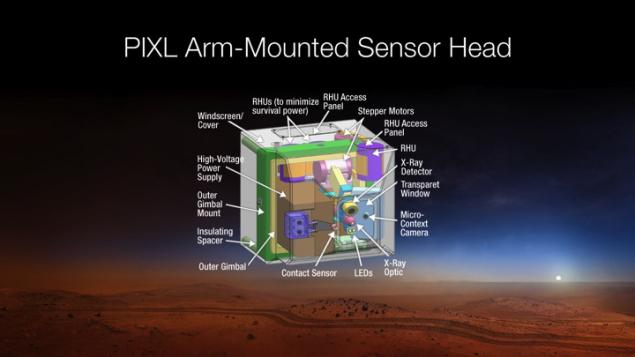
Scanning Habitable Environments with Raman & amp; Luminescence for Organics and Chemicals (SHERLOC) - ultraviolet Raman spectrometer that will provide small-scale images to determine the mineralogy of small-scale and organic substances detected. SHERLOC will be the first ultraviolet spectrometer on the surface of Mars, and will interact with the other instruments in the payload.
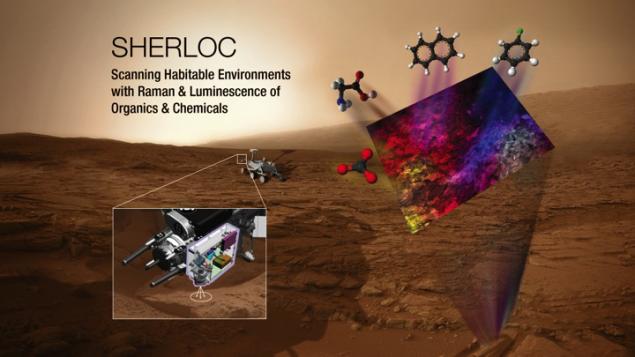
After the announcement of the new NASA program spoke about the details of the new mission. The organization also responded to a number of questions users viewed a presentation of the Mars mission 2020. For example, NASA experts will change the structure of the rover's wheels to make them stronger Curiosity wheels. As is known, this time with the rover wheel received considerable damage.
Undergo changes and the rover landing system. The general scheme of planting is the same as that of Curiosity. But experts can now identify yourself when you need to open the parachute system, not only the speed at which the parachute should open automatically. According to the system developer, it can reduce the rover landing zone twice. As mentioned above, the rover's camera can record the sound. Work chambers begin at the stage of descent device to record all the details.
If desired, you can view a video presentation of the new system.
Source: geektimes.ru/post/278518/

To the question "Is there life on Mars?" Scientists still have no answer. Specifically, it could be sooner. There may be in one form or another and now. But all this - the assumptions and assumptions without a clear answer. To get the answer, NASA proposes to send a new rover to Mars, called the Mars 2020.
The agency issued a "roadmap" of the rover landing on Mars. Until the date of the final stage of the journey - in February 2021. Posted image and future rovers. All stages of preliminary preparation for the implementation of the project completed.
The new phase involves the approval of the final version of the structure of the rover and the beginning of the manufacture of individual elements of the system. Once all the parts are made, the system will begin assembly, check its functionality and sending a rover to the launch site. The transition to this phase, according to project manager George Tau (George Tau) should occur in the next year.
Since 2020 Mars mission is the "heir" Curiosity mission, structure and some elements of the new rover is very similar to what was used in the Curiosity. This scientist did not have to re "reinvent the wheel" by creating a Mars 2020. Some key parts and components have made the rover as technical base remained from the previous project.
Model 2020 will collect Martian soil samples and check them for signs of microbial life. This problem is not posed in front of Curiosity. 2020 rover will have to collect and store the selected samples - of the predecessor also did. Samples were once planned to send to Earth for further inspection. So far, specific plans for this stage there is no mission. "Mission Mars 2020 - the first step in a multi-stage campaign for the return of the sealed and collected images of the Martian rocks. The mission is an important milestone in the implementation of the program Journey to Mars. The purpose of the program - to determine whether there was life on Mars before ... "- said Dzhoffri Yoder (Geoffrey Yoder), one of Mars 2020. program managers select and put into sealed capsule is scheduled for 30 of the most interesting science rocks of Mars samples.
It is known that the rover will explore Mars in 2020 is one of the regions of the Red Planet, which, as scientists believe, was previously the existence of a favorable environment for microbial life. While the region is not defined - scientists are considering several possible places of interest in terms of research.

At Mars rover in 2020 will be 7 major scientific instruments. General equipment rover - better than Curiosity. The first tool - this is the main chamber of the rover (the part that looks like a robot's head). The camera is more perfect than the camera, which was equipped with Curiosity. Mastcam-Z can make panoramic images and stereoscopic images as the camera 2020 predecessor model. But she has more optical zoom than the previous model. In fact, all of the cameras in 2020 Mars better than at Curiosity, the rover Plus except video and can record sound. And of course, the new rover will also be able to do selfie.
SuperCam the model 2020 - this is an advanced version of ChemCam, Curiosity instrument. In fact, this powerful laser gun, which the rover will "shoot" on the rocks of Mars and analyze the products formed. All of this allows us to identify and understand the elementary mineral composition of the rock. After receiving the data on the analysis of rocks, Earth scientists decide to prioritize the study of various regions of Mars, where lie the different rocks.

The third tool rover - MOXIE (Mars Oxygen ISRU Experiment). It will capture carbon dioxide and converting it into pure oxygen. This experiment will help you understand to be seen whether future colonists on Mars getting enough for the needs of the colony oxygen. Oxygen is needed for the creation of rocket fuel.
The fourth tool - MEDA Mars (Environmental Dynamics Analyzer). It is necessary to study the Martian weather. Sensors measure the device temperature, wind speed and direction, pressure, relative humidity, the size and shape of dust
The fifth tool - RIFMAX. It georadiolokator. He will be able to "look" at the surface of Mars to a depth of 10 meters (some sources say 500 m) with a resolution of 5-20 centimeters. Thus, thanks to RIFMAX scientists will map the surface layers of Mars rover landing area.
Planetary Instrument for X-ray Lithochemistry (PIXL) - X-ray fluorometric spectrometer, which will also contain a thermal imager with a high resolution in order to determine the composition of the Martian soil on rare elements. PIXL can more accurately detect and analyze the elemental composition than was previously possible.

Scanning Habitable Environments with Raman & amp; Luminescence for Organics and Chemicals (SHERLOC) - ultraviolet Raman spectrometer that will provide small-scale images to determine the mineralogy of small-scale and organic substances detected. SHERLOC will be the first ultraviolet spectrometer on the surface of Mars, and will interact with the other instruments in the payload.

After the announcement of the new NASA program spoke about the details of the new mission. The organization also responded to a number of questions users viewed a presentation of the Mars mission 2020. For example, NASA experts will change the structure of the rover's wheels to make them stronger Curiosity wheels. As is known, this time with the rover wheel received considerable damage.
Undergo changes and the rover landing system. The general scheme of planting is the same as that of Curiosity. But experts can now identify yourself when you need to open the parachute system, not only the speed at which the parachute should open automatically. According to the system developer, it can reduce the rover landing zone twice. As mentioned above, the rover's camera can record the sound. Work chambers begin at the stage of descent device to record all the details.
If desired, you can view a video presentation of the new system.
Source: geektimes.ru/post/278518/
9 mini-desserts that your guests will eat in one bite
On the day of his seventieth birthday, KS Stanislavsky

